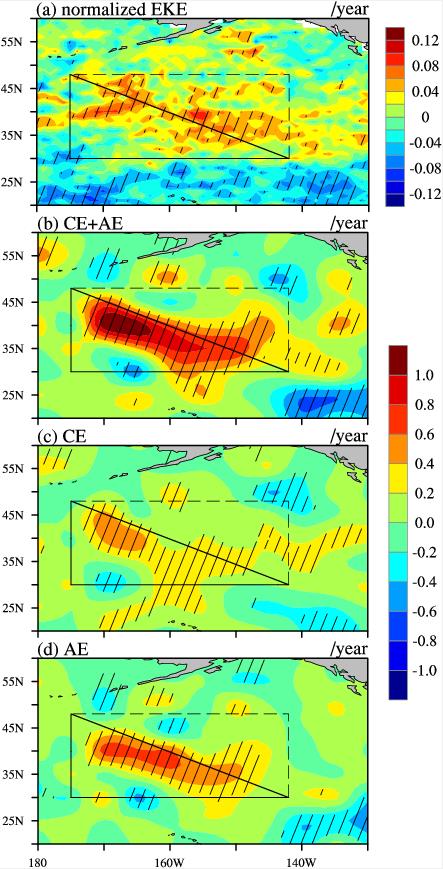State Key Laboratory of Numerical Modeling for Atmospheric Sciences and
Geophysical Fluid Dynamics (LASG)
Institute of Atmospheric Physics, Chinese Academy of Sciences

Vol. 4/No.4 December 2017
[Climate Change] Increased Eddy Activity in the Northeastern Pacific during 1993–2011
Highlights:
1. Both the eddy kinetic energy (EKE) and eddy occurrence number (EON) present prominent increases, with interannual and decadal variabilities northeast of the Hawaiian–Emperor seamounts.
2. The increasing EON is mainly due to the prolongation of eddy lifetimes associated with eddy intensification, particularly for anticyclonic eddies (AEs).
3. The prolongation of eddy lifetimes results from weakened surface winds. The enhanced anticyclonic wind stress curl (WSC) injects more energy into the AEs in the study domain, providing a more suitable environment for their growth.
As a nonnegligible component of the energy cycle of the global oceans, ubiquitous mesoscale eddies play a vital role in transporting mass, salt, heat, and biogeochemical tracers in the ocean, as well as in air–sea interactions. However, few studies have focused on the relationship between the long-term variability of eddy activity and large-scale climate modes in the Northeastern Pacific (NEP) region (20⁰–60⁰N; 180⁰–130⁰W, i.e., the solid rectangle in the Figure 1), where large variances of both the Pacific decadal oscillation (PDO) and the North Pacific Gyre Oscillation (NPGO) happen. Recently, Ding Mengrong, Lin Pengfei, Liu Hailong from LASG, Institute of Atmospheric Physics, Chinese Academy of Sciences investigate the long-term variability of eddy activities in the NEP and the mechanism behind it by using a global mesoscale eddy trajectory dataset.
Their results show that both the EKE and EON in the northeastern region of the Hawaiian–Emperor seamounts present significant increases during 1993-2011, along with interannual and decadal variabilities. The increases of eddy lifetime, particularly for AEs, presents a spatial pattern similar to the trend of the EON in the study domain, which means that the increase in eddy lifetime is the primary contributor to the increase in EON. The eddy attenuation time scale is inversely proportional to the surface wind speed; therefore, the prolongation of eddy lifetime is related to the weakened trend of wind speed over the study domain. Besides, the enhanced anticyclonic WSC anomaly is found to provide a more suitable environment for the growth of AEs since the background WSC is in the same direction as that of AEs, which results in more energy being injected into the AEs. This result partially explains why the increasing trend of AEs contributes more to the increasing trend of eddy activity than that of cyclonic eddies (CEs) in the NEP during 1993–2011. The decadal climate modes, such as the PDO and NPGO, may also modulate eddy activity in the NEP by exerting fluctuations in the surface wind system.

Figure 1. The linear trends (yr-1) of (a) normalized EKE, (b) EON, (c) CEON, and (d) AEON from 1993 to 2011. The hatched areas indicate the linear trend exceeding the 95% confidence level.
Reference: Ding, M., Lin, P., Liu, H., and Chai, F., 2017: Increased eddy activity in the northeastern pacific during 1993-2011. Journal of Climate, doi:.10.1175/JCLI-D-17-0309.1.
http://journals.ametsoc.org/doi/abs/10.1175/JCLI-D-17-0309.1
Contact: Pengfei Lin (linpf@mail.iap.ac.cn) or Hailong Liu (lhl@lasg.iap.ac.cn)
E-mail: lasg_newsletter@lasg.iap.ac.cn
Editors: Chuanyi Wang (wangcy@lasg.iap.ac.cn), Kangjun Chen(ckj@lasg.iap.ac.cn)